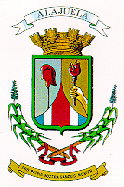Alajuela (canton)
Alajuela is the name of the first canton in the province of Alajuela in Costa Rica. The canton covers an area of 388.43 square kilometres (149.97 sq mi),[1] and has a population of 285,259 (estimate as of 2013).[2] Its capital is the provincial capital city of Alajuela. It is a major area for the production of coffee, strawberries and ornamental plants.
Alajuela | |
|---|---|
Cantón | |
 Alajuela city | |
 Seal | |
 Location of Alajuela Canton in Alajuela Province | |
| Country | Costa Rica |
| Province | Alajuela |
| Area | |
| • Total | 388.43 km2 (149.97 sq mi) |
| Population (June 2013) | |
| • Total | 285,259 |
| • Density | 730/km2 (1,900/sq mi) |
History
Alajuela became a province and a canton on December 7, 1848.[3]
Geography
Northward from the city of Alajuela, the canton continues along the border with the province of Heredia to its east, encompassing a strip of the Cordillera Central (Central Mountain Range) between Poas Volcano and Barva Volcano. On the Caribbean side of the mountains, the canton takes in a portion of the Sarapiquí area. The Río Poás (Poas River) forms the major portion of the canton's western border, finally giving way to the Río Poasito as the territory ascends into the Cordillera Central.
Southwest of the city of Alajuela, the canton of Alajuela ends at the confluence of the Río Grande (Great River) and the Río Virilla (Virilla River).
Districts
The canton of Alajuela is subdivided into 14 districts (distritos):[4]
- Alajuela
- San José
- Carrizal
- San Antonio
- Guácima
- San Isidro
- Sabanilla
- San Rafael
- Río Segundo
- Desamparados
- Turrúcares
- Tambor
- Garita
- Sarapiquí
Economy
The canton is a major area for the production of coffee, strawberries, mangoes and ornamental plants.[5][6] The Doka Estate lies within the canton, in Sabanilla District, and is a major coffee producing estate, supplying directly to Starbucks.[7]
Landmarks

In the center of Alajuela, next to Parque de Alajuela, also known as "Parque de los Mangos", is Alajuela Cathedral, whose main feature is its red dome. This park is s popular place for locals to socialize, especially in the afternoons. One block west of the park is the Mercado Central de Alajuela, a bustling shopping centre. Poás Volcano National Park is about 37 kilometres (23 mi) north of Alajuela city and is known for its five waterfalls at La Paz Waterfall Gardens.[8]
To the north of the Central Park is the Museo Histórico Cultural Juan Santamaría. This museum, situated in a building built in 1894-5, which was formerly a prison in the barracks of Alajuela, contains many historical maps, artifacts and portraits of the 1856 - 1857 campaign. In 1977 it became the headquarters of the Centro de Investigación para el Perfeccionamiento Técnico (CIPET), an institution of the Ministry of Public Education.[9]
References
- Instituto Geográfico Nacional (IGN), 2001
- Estadísticas Vitales 2013 Archived 2015-04-02 at the Wayback Machine - INEC
- "Historia" (in Spanish). Alajuelenses.com. Retrieved 26 August 2019.
- "División Territorial Administrativa de Costa Rica" (PDF) (in Spanish). Instituto de Fomento y Asesoria Municipal (IFAM). 5 May 2009. Archived from the original (PDF) on 2 August 2015.
- McNeil, John (2011). "The Rough Guide to Costa Rica". Rough Guides. p. 121.
- Drew, Keith (2012). "The Rough Guide to Costa Rica". Rough Guides. p. 133.
- Glassman, Paul (2006). "Costa Rica Guide". Open Road Publishing. p. 43.
- "Fodor's Costa Rica 2012". Fodor's. p. 267.
- "Museo (arquitectura)" (in Spanish). Museo Histórico Cultural Juan Santamaría. Retrieved 26 August 2019.